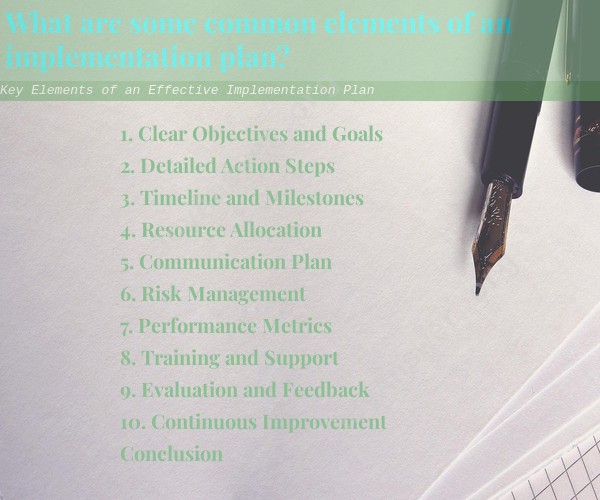What are some common elements of an implementation plan?
An implementation plan is a crucial tool for turning strategies and ideas into actionable steps. It provides a roadmap for executing projects and initiatives successfully. To ensure a smooth and organized implementation process, consider including the following key elements in your plan:
1. Clear Objectives and Goals
Define the specific objectives and goals of the implementation. What are you aiming to achieve? Clearly outline the desired outcomes and results to provide a sense of purpose and direction.
2. Detailed Action Steps
Break down the implementation process into detailed action steps. Each step should be clearly defined, with assigned responsibilities, deadlines, and resources required. A well-structured plan ensures that everyone knows what needs to be done and when.
3. Timeline and Milestones
Create a timeline that outlines the start and end dates for each action step. Include key milestones or checkpoints to track progress and ensure that the project stays on schedule. This helps in monitoring and addressing any potential delays.
4. Resource Allocation
Identify the necessary resources, including personnel, budget, equipment, and technology. Ensure that resources are allocated appropriately to support the successful execution of each step.
5. Communication Plan
Develop a communication plan that outlines how information will be shared and disseminated among team members, stakeholders, and relevant parties. Effective communication promotes collaboration and transparency.
6. Risk Management
Anticipate potential challenges and risks that could arise during implementation. Develop strategies to mitigate these risks and contingency plans to address unforeseen issues that may arise.
7. Performance Metrics
Establish key performance indicators (KPIs) or metrics to measure the success and impact of the implementation. Regularly track and evaluate progress against these metrics to ensure that the project is on track.
8. Training and Support
Provide training and support for team members involved in the implementation. Ensure that they have the necessary skills and knowledge to carry out their tasks effectively.
9. Evaluation and Feedback
Include mechanisms for ongoing evaluation and feedback. Regularly assess the implementation process, gather feedback from stakeholders, and make adjustments as needed to optimize outcomes.
10. Continuous Improvement
Emphasize a culture of continuous improvement. Use lessons learned from the implementation to refine processes, enhance future projects, and drive organizational growth.
Conclusion
An effective implementation plan is a comprehensive guide that outlines the steps, resources, and strategies required to achieve your objectives. By including these key elements in your plan, you can enhance the likelihood of successful implementation and drive positive outcomes for your projects and initiatives.












